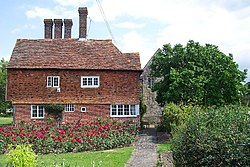Horne's Place Chapel
| Horne's Place Chapel | |
|
Kent | |
|---|---|
 Hornes Place and Chapel, Kent | |
| Type: | chapel |
| Location | |
| Grid reference: | Expression error: Unexpected < operator.&y=Expression error: Unexpected < operator.&z=120 TQ 95753086 |
| Location: | 51°2’37"N, 0°47’28"E |
| Village: | Appledore |
| History | |
| Built 1276 | |
| chapel | |
| Information | |
| Owned by: | English Heritage |
Horne's Place Chapel, is a late mediæval chapel built as a private chapel to the adjacent house of the same age, Horne's Place. The house and chapel stand in Appledore in Kent.
The house is a private house, and designated a Grade II* listed building.[1] The chapel though is open to view and managed by English Heritage.
History
In the reign of King John (during 1166 – 1216), 'Ralph de Horne' (of Kenardington), was one of the recognitores magnæ assisæ, or justices of the great assize.[2]
Then in 1276, King Edward I granted land containing the manor to Matthew Horne (Ralph's son),[3] and the house remained in his family until the sixteenth century, taking its name to this day from that family. It was Matthew Horne who built the chapel: a domestic chapel which allowed the Horne family to attend services conveniently at home rather than obliging them to travel to the parish church. The chapel was licensed for divine service in 1366 by Archbishop Simon Langham.[3] Receipt of such a licence for worship was an indicator of the family's high status.
Matthew's descendant, William Horne, was one of the conservators of the peace in 1367.[2]
In 1392, Henry Horne (MP) inherited Horne's Place,[4]. In 1406, Michael Horne (son of Matthew Horne) became a Sheriff of Kent.[5] and he is thought to be buried in a tomb in the chapel.[2]
Queen Mary I granted the house to Philip Chute (a yeoman of the guard in 1536).[6] The chapel was thereafter used as a barn in the 19th and early 20th centuries.[3]
Construction
The chapel is 26 feet by 13 feet, built of Kentish ragstone and rubble with a tiled roof. Roof was re-placed in 1520. It also has a stone-flagged floor.[1]
It has a double cinquefoil window and blocked 4 centre arch on the west side.
The south side has an ogee opening (moulded arch) with a window of 3 cinquefoil-headed lights. The east side has a traceried window with a triple cinquefoil symbol. The northside has a similar window.[1]
The chapel was originally linked to the hall wing of the manor house by a doorway, which is now blocked, along its north wall.[3]
The chapel also has barrel-vaulted undercroft and a roof from 1520 of 4 heavily moulded arch braces rising from stone corbels.[1] The corbels are decorated with Catherine wheels.[3]
Nikolaus Pevsner has described the details of this 'exquisite little building' as being 'of the utmost refinement, far above the level of the local parish churches' in his Buildings of England.[3]
References
- ↑ 1.0 1.1 1.2 1.3 Horne's Place Chapel, Appledore - British Listed Buildings
- ↑ 2.0 2.1 2.2 Hasted, Edward: The History and Topographical Survey of the County of Kent (1798), pages 244-249
- ↑ 3.0 3.1 3.2 3.3 3.4 3.5 Horne's Place Chapel: History and research
- ↑ "HORNE, Henry, of Horne's Place in Appledore, Kent". www.historyofparliamentonline.org. http://www.historyofparliamentonline.org/volume/1386-1421/member/horne-henry. Retrieved 5 August 2014.
- ↑ Hasted, Edward: The History and Topographical Survey of the County of Kent (1797), pages 177-213}}
- ↑ "CHUTE (CHOWTE), Philip (by 1506-67), of Horne Place, Appledore, Kent". www.historyofparliamentonline.org. http://www.historyofparliamentonline.org/volume/1509-1558/member/chute-(chowte)-philip-1506-67. Retrieved 5 August 2014.